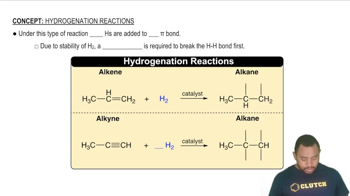Benzoic acid, C6H5COOH, melts at 122 °C. The density in the liquid state at 130 °C is 1.08 g/cm3. The density of solid benzoic acid at 15 °C is 1.266 g/cm3. (b) If you converted a cubic centimeter of liquid benzoic acid into a solid, would the solid take up more, or less, volume than the original cubic centimeter of liquid?
Ch.11 - Liquids and Intermolecular Forces
Chapter 11, Problem 17c
(c) Which type of intermolecular attractive force operates only between the hydrogen atom of a polar bond and a nearby small electronegative atom?
 Verified step by step guidance
Verified step by step guidance1
Identify the type of intermolecular force described in the question. The force is specific to interactions involving hydrogen atoms and electronegative atoms like oxygen, nitrogen, or fluorine.
Recognize that this intermolecular force occurs when hydrogen is covalently bonded to a highly electronegative atom, making the hydrogen partially positive.
Understand that the partially positive hydrogen atom is attracted to the lone pair electrons of a nearby electronegative atom in another molecule, forming a special type of dipole-dipole interaction.
Recall the name of this intermolecular force, which is named after the elements typically involved: hydrogen and an electronegative atom such as nitrogen, oxygen, or fluorine.
Conclude that this type of force is known as hydrogen bonding, which is a strong type of dipole-dipole attraction and crucial in many biological and chemical systems.

Verified video answer for a similar problem:
This video solution was recommended by our tutors as helpful for the problem above.
Video duration:
1mWas this helpful?
Key Concepts
Here are the essential concepts you must grasp in order to answer the question correctly.
Hydrogen Bonding
Hydrogen bonding is a specific type of intermolecular force that occurs when a hydrogen atom, covalently bonded to a highly electronegative atom like oxygen, nitrogen, or fluorine, interacts with another electronegative atom. This interaction is characterized by a strong dipole-dipole attraction due to the significant difference in electronegativity, leading to a partial positive charge on the hydrogen and a partial negative charge on the electronegative atom.
Recommended video:
Guided course

Hydrogenation Reactions
Polar Bonds
Polar bonds form when there is a significant difference in electronegativity between two atoms, resulting in an uneven distribution of electron density. This creates a dipole moment, where one end of the bond becomes partially negative and the other partially positive. In the context of hydrogen bonding, the polar bond is crucial as it allows the hydrogen atom to participate in attractive interactions with other electronegative atoms.
Recommended video:
Guided course

Molecular Polarity
Intermolecular Forces
Intermolecular forces are the forces of attraction or repulsion between neighboring particles (atoms, molecules, or ions). These forces are weaker than covalent or ionic bonds and play a significant role in determining the physical properties of substances, such as boiling and melting points. Understanding the different types of intermolecular forces, including hydrogen bonds, dipole-dipole interactions, and London dispersion forces, is essential for predicting the behavior of substances in various states.
Recommended video:
Guided course

Intermolecular vs Intramolecular Forces
Related Practice
Textbook Question
1
views
Textbook Question
(a) Which type of intermolecular attractive force operates between all molecules?
1
views
Textbook Question
(b) Which type of intermolecular attractive force operates only between polar molecules?
1
views
Textbook Question
(b) Which of these kinds of interactions are broken when a liquid is converted to a gas?
1
views
Textbook Question
Describe the intermolecular forces that must be overcome to convert these substances from a liquid to a gas: (a) SO2, (b) CH3COOH, (c) H2S.
1
views
Textbook Question
Which type of intermolecular force accounts for each of these differences? (a) CH3OH boils at 65 °C; CH3SH boils at 6 °C. (d) Acetone boils at 56 °C, whereas 2-methylpropane boils at -12 °C.
1
views
